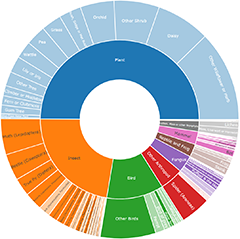Mammals
Announcements
Earlier this week, NatureMapr suffered a large scale denial of service style attack, causing a sustained outage over several days.It is important to stress that sensitive data was not at risk at any s...
Continue reading
Change to user profile page structure
Sensitive data handling improvements
Discussion
Sminthopsis murina
Trichosurus vulpecula
BTW, with that handle, are you from Australia Zoo or connected to the Steve Irwin family?
Macropus giganteus
I'm not aware of a good reason for suppressing it because this species is not desirable for private captive keeping and is difficult to detect and difficult to harvest. On those grounds a lot of reptiles which we don't suppress would be better candidates for suppression imo. Also it is not the kind of species which both attracts people to view it and is sensitive to their presence like e.g. a Wedge-tailed Eagle nest. Please consult other opinions though, as well as mine.
Also I'm not aware of good reasons to concern ourselves with the question many people are raising in discussions on email and verbally, as to whether this animal originated from the captive colony at Tidbinbilla. (Apparently the gates were left open in 2020 when the bush fire was approaching.) The point is made in a way to discount the record. However if there are SBB living out there in the wild, it does not matter for conservation purposes whether their origin was deliberate reintroduction, accidental reintroduction, or whether they are a remnant natural wild population. Remains of SBB were found in eagle nests during WTE research in 2002 and 2003, well before there was a captive colony at Tidbinbilla. Therefore we have known since 2003 that there is a wild population of SBB somewhere in the Canberra area. If this record is not from that wild source, there is another wild source yet to be found in the area. You can contact me separately if you like on don.fletcher999@gmail.com or 0428 48 9990.
Isoodon obesulus obesulus
Significant sightings
- Pseudocheirus peregrinus at Bywong, NSW
- Petaurus notatus at Bywong, NSW
- Phascolarctos cinereus at Jacka, ACT
- Phascolarctos cinereus at Tallong, NSW
- Petauroides volans at Uriarra Village, ACT
- Cercartetus nanus at Tinderry Mountains
- Mustela furo at Jerrabomberra Wetlands
- Acrobates pygmaeus at Cotter River, ACT
- Petaurus australis australis at Cotter River, ACT
- Phascolarctos cinereus at Tinderry, NSW
Recent activity
Vombatus ursinus at Hawker, ACT
Vombatus ursinus at Hawker, ACT
Vombatus ursinus at Hawker, ACT
Trichosurus vulpecula at Bowning, NSW
Vulpes vulpes at Kosciuszko National Park
Top contributors
- darren.leroux 962
- DMeco 575
- ChrisAllen 420
- Waterwatch 384
- MichaelBedingfield 320
- RodDeb 273
- MB 254
- HelenCross 228
- MatthewFrawley 210
- AustralianPlatypusConservancy 204
Top moderators
- MichaelMulvaney 1.8K
- DonFletcher 1.7K
- MichaelBedingfield 1.6K
- Liam.m 1K
- darren.leroux 962
- CarbonAI 450
- Waterwatch 402
- Gaia 297
- DMeco 195
- WingsToWander 133
































































































